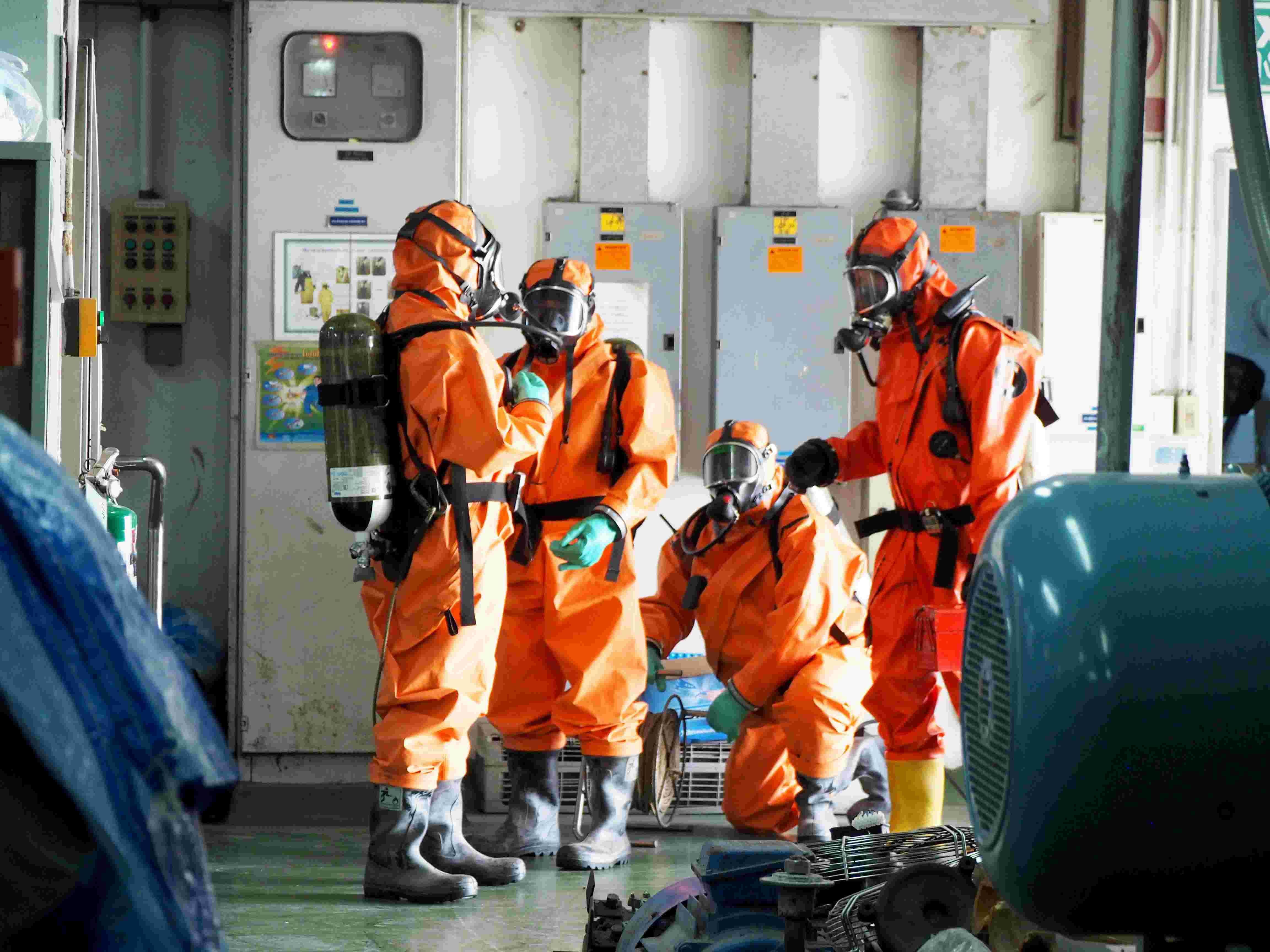
Important Fire Extinguisher Tips
Fire extinguishers are commonly found in workplaces, homes, and public spaces. But what's the point if...


Corrosive materials are present in almost every workplace. From batteries to disinfectants, they are used in a variety of things, so it is important to recognize them. Corrosive materials can be defined as any liquid that has a severe corrosion rate on steel, which makes them very dangerous. Workers must be aware of their hazards and how to work safely with them. Corrosive chemicals can attack and destroy body tissues by dermal exposure. After flammable liquids, corrosive chemicals are the second most commonly used or transported hazardous material.
There are two main types of materials that are powerful enough to corrode steel:

In encounters with corrosive chemicals, the eyes, skin, and respiratory system are often the primary areas of the body susceptible to harm. This vulnerability can arise from various scenarios, such as:
Chemicals can pose a threat when poured, leading to potential splashes that may come into contact with the eyes, skin, or respiratory passages.
Mixing or diluting corrosive substances, as well as engaging in chemical reactions, can generate splashes that might affect the eyes, skin, or respiratory system.
Accidental spills during the transportation of chemical containers, as well as leaks from compromised containers, can result in exposure to corrosive substances.
Open or leaking containers may emit corrosive vapors, posing a risk to the respiratory system if inhaled.
Some acids and bases are so corrosive that they can cause instant and severe chemical burns just by momentary exposure. There are three ways in which workers can encounter these hazards.
Exposure to dust particles from any solid corrosive chemical can cause severe internal and external injuries. Massive exposure to these forms of solids may result in a fatality in a matter of a few minutes.
Dermal exposure to any corrosive liquid can cause instantaneous chemical burns. Avoid splashing when handling liquid corrosives.
This is the most dangerous of all the three hazards. When a corrosive vapor cloud is generated by accident, large-scale site evacuation is usually required. Fuming corrosive liquids have the potential to spontaneously produce vapor clouds. Injuries from vapor exposure can range from permanent damage to the eyes, throat, airway, and respiratory system.
Workers should take extreme precautions and follow OSHA’s recommended preventive measures to minimize the chance of the occurrence of exposure when handling any corrosive materials.
The most common dermal exposure to corrosive chemicals can be fully prevented by wearing appropriate protective equipment. For example, in some situations, it’s required by OSHA to wear a face shield or work from behind a splash shield in addition to the standard protection. Personal Protective Equipment requirements may vary depending on the type and concentration of corrosive materials being handled, as well as the specific job tasks. However, here are some general recommendations for PPE when working with corrosives:
Safety goggles or a full-face shield with splash protection should be worn to protect the eyes from splashes, mists, or fumes of corrosive substances.
Chemical-resistant gloves made of materials such as nitrile, neoprene, or PVC should be worn to protect the hands from direct contact with corrosive substances. Make sure that the gloves are appropriate for the specific corrosive material being handled, as different materials have different resistance levels.
Wear chemical-resistant clothing, such as coveralls or aprons, to protect the skin and clothing from splashes or spills. Make sure that the clothing covers the entire body, including arms and legs.
Chemical-resistant boots or shoe covers can help protect the feet from spills or splashes.

Depending on the nature of the corrosive substance and the potential for inhalation exposure, respiratory protection may be necessary. Use appropriate respiratory protective equipment, such as a mask or respirator, with the correct filter or cartridge for the specific corrosive material.
A chemical-resistant hood or headgear may be necessary to protect the head and neck from splashes or vapors.
Consider using additional protective equipment such as chemical-resistant aprons, face shields, or hoods depending on the level of exposure.
When exposed to a corrosive material, the best way to stop the chemical reaction is flushing. It is done to instantly neutralize the material. After flushing is complete, the victim should be treated with standard first-aid practices.
However, keep in mind that the extent of injury depends on the following variables:
Corrosives pose a serious threat to the life and health of workers, It's crucial to pick the right Personal Protective Equipment (PPE) and use it properly when dealing with corrosive substances. Keeping workers safe involves looking at the specific characteristics of these corrosive materials. Depending on the type and strength of the corrosive substance, you need different types of protection, such as eye protection, gloves, body covering, foot protection, respiratory protection, and additional gear like chemical-resistant aprons or hoods. So, choosing the appropriate protection depends on what kind of corrosive substance you're working with and how strong it is.

Fire extinguishers are commonly found in workplaces, homes, and public spaces. But what's the point if...

Working at heights can be dangerous, especially for jobs like construction, window cleaning, or telecommunications...

Scaffolds are the backbone of construction projects, providing a stable platform for workers to...

Combustible dust refers to fine particles that can ignite and cause explosions when they're in the air...

In our daily lives, we see signs and symbols everywhere that guide us, inform us, and keep us safe. From traffic signs on the roads to hazard...

In our daily lives, we are constantly surrounded by potential hazards that we often overlook. One such danger...

A hand pallet jack, also known as a pallet truck, is a manual device designed to lift and move heavy...

Working at an oilfield could potentially expose you to hydrogen sulfide (H2S). It has a faint smell of rotten eggs...

Industrial ergonomics is the practice of designing workplace environments that match the capabilities and...

Safety is important in any field, especially in construction, where mistakes can have serious...

As we continue to push the boundaries of architectural design, it’s clear that concrete and masonry will...

Excavation and trenching are some of the most dangerous tasks in construction work. The moment...

The importance of environmental responsibilities has to be emphasized. As we observe the increasing...

Hot work refers to any activity or process that creates a source of ignition, such as flame, heat, or spark...

Harassment in the workplace can happen from different people...

Driving is a big part of many jobs. Whether it’s commuting to meetings, making deliveries, or traveling...

In the construction, mining, and demolition industries, controlled explosions are commonly used for...

In today’s fast-paced world, where maintaining high productivity is a continual requirement, effective supervision plays a pivotal...

A learning management system, or LMS, is a platform or software application designed to...

In the present time, Drugs and alcohol are making a big impact on society, extending into...

Working with electrical equipment comes with serious hazards, one of these...

Corrosive materials are present in almost every workplace. From...

Crane operator safety training deals with procedures and measures...

The safety of employees is paramount for any company and employer. It’s also the...

Hand and Power Tools are common parts of our routine lives and are...

Truckers face a high risk of injury and death in their line of work because they spend long...

A forklift is a powered industrial truck with twin forks attached to the front that can be raised and lowered...

An aerial lift is a type of heavy equipment designed to lift individuals...

Asphalt is one of the most common materials used for road paving,...

In today's bustling industries,...

In today's rapidly evolving world, workplace safety is a critical aspect of...

Scissor lifts are versatile aerial work platforms widely used in various industries, including construction,...

Emergencies and disasters can catch people off guard, particularly when they have a personal impact on...

OSHA unveiled a national emphasis...

In the pursuit of ensuring safe and healthy working environments, the...

In today's world, maintaining a safe and healthy work environment is...

When it comes to workplace safety, fall protection is a critical aspect that...

Working in the construction industry...

The construction industry is an...

In the bustling world of construction, ladders are indispensable tools,...

The 40-Hour Site Safety training and...

OSHA 10 and OSHA 30 are both training programs offered by the Occupational Safety...

As the winter season blankets the world in frosty temperatures,...

As the temperatures rise and global warming becomes an increasingly...

Ensuring a safe working environment is paramount for any organization,...

Asbestos, a naturally occurring mineral known for its heat resistance...

In any workplace, ensuring the safety and well-being of employees is of...

The SST card is a certification/proof that you have successfully completed your training with an authorized...

Creating a safe and inclusive work environment is crucial for the well-being and productivity...

Transporting hazardous materials is a critical and necessary activity in our...

Under the local law of 196 of 2017 (NYC department of buildings), Supervisors at job sites with...

“SST” is site safety training required by NYC Local Law 196 of 2017 for construction workers...

In any workplace, ensuring the safety and well-being of employees is paramount. Accidents and medical...